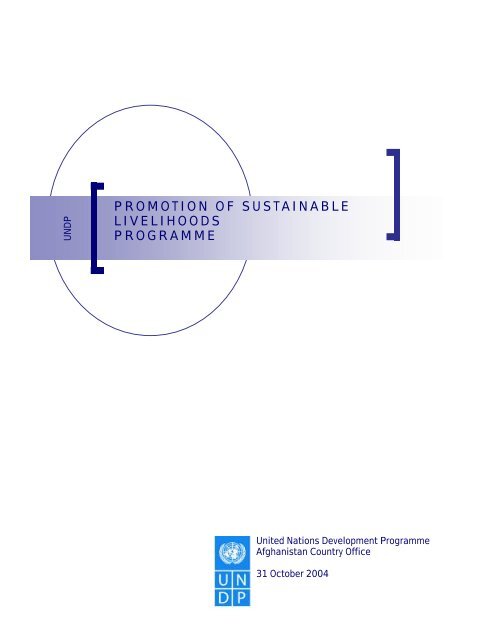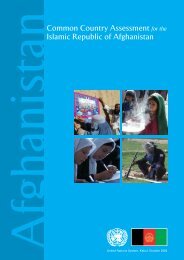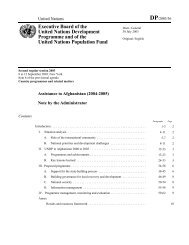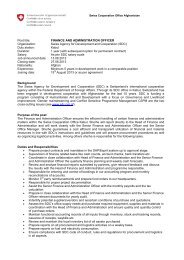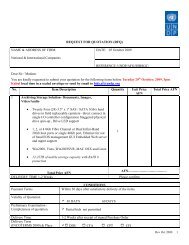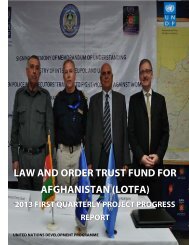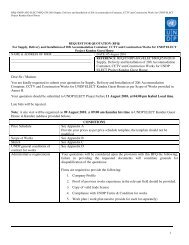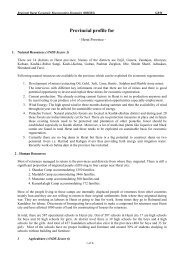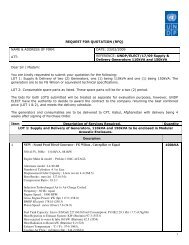Promotion of Sustainable Livelihoods - UNDP Afghanistan
Promotion of Sustainable Livelihoods - UNDP Afghanistan
Promotion of Sustainable Livelihoods - UNDP Afghanistan
You also want an ePaper? Increase the reach of your titles
YUMPU automatically turns print PDFs into web optimized ePapers that Google loves.
<strong>UNDP</strong><br />
PROMOTION OF SUSTAINABLE<br />
LIVELIHOODS<br />
PROGRAMME<br />
United Nations Development Programme<br />
<strong>Afghanistan</strong> Country Office<br />
31 October 2004
<strong>UNDP</strong> <strong>Afghanistan</strong> <strong>Promotion</strong> <strong>of</strong> <strong>Sustainable</strong> <strong>Livelihoods</strong> Programme<br />
Table <strong>of</strong> Contents<br />
<strong>UNDP</strong> <strong>Afghanistan</strong> Programme .......................................................................3<br />
Support to the Bonn Agreement and Bridging the Development Gap ......................3<br />
<strong>Promotion</strong> <strong>of</strong> <strong>Sustainable</strong> <strong>Livelihoods</strong> Programme ........................................................4<br />
Reconstruction, Rehabilitation and Employment Generation ...............5<br />
National Area-Based Development Programme (NABDP) .........................................5<br />
Recovery and Employment <strong>Afghanistan</strong> Programme (REAP)....................................8<br />
Partnership for Private Sector Development (PPSD)...................................................10<br />
Reduction <strong>of</strong> Threats to Human Security ..........................................................12<br />
<strong>Afghanistan</strong>’s New Beginnings Programme (ANBP)..................................................12<br />
Mine Action Programme .....................................................................................................14<br />
Support to Mine Action Capacity Building in <strong>Afghanistan</strong> .......................................17<br />
Capacity Building <strong>of</strong> the Government Department <strong>of</strong> Disaster Preparedness.......18<br />
National Human Development Report.............................................................................20<br />
Programme Support Facility...............................................................................................22<br />
Pipeline.....................................................................................................................................24<br />
Ogata Initiative.......................................................................................................................24<br />
2
<strong>UNDP</strong> <strong>Afghanistan</strong> <strong>Promotion</strong> <strong>of</strong> <strong>Sustainable</strong> <strong>Livelihoods</strong> Programme<br />
<strong>UNDP</strong> <strong>Afghanistan</strong> Programme<br />
Within the broad national development framework are many cross-cutting priorities that address gender<br />
equality, security and the rule <strong>of</strong> law, administrative and financial reforms, human rights, environmental<br />
integrity, the return <strong>of</strong> refugees and internally displaced persons to their communities, and reintegration <strong>of</strong><br />
former combatants into society. Guided by the requirements set forth in the NDF, <strong>UNDP</strong> <strong>Afghanistan</strong> focuses<br />
its activities on the following <strong>UNDP</strong> global practice areas: poverty reduction, democratic governance, and<br />
crisis prevention and recovery.<br />
All <strong>of</strong> <strong>UNDP</strong>’s activities take place under the leadership <strong>of</strong> the interim Afghan Government and in close<br />
collaboration with ministries, agencies, and donors leading programmes within the consultative group<br />
process. <strong>UNDP</strong> works collaboratively with all partners to empower Afghan women and promote gender<br />
equality in <strong>Afghanistan</strong>, ensuring that gender issues are consistently mainstreamed and carefully paced. All<br />
<strong>UNDP</strong> programme activities aim to consolidate peace, enhance security and promote respect for the rule <strong>of</strong><br />
law. In addition to direct support to the national security sector, <strong>UNDP</strong> projects enhance government<br />
institutional capacity to provide public services and to create an enabling environment for legitimate<br />
livelihoods.<br />
Human development indicators are critical tools for development, and <strong>UNDP</strong> is acutely aware <strong>of</strong> and<br />
responsive to them. The release <strong>of</strong> the first National Human Development Report (NHDR) <strong>of</strong> <strong>Afghanistan</strong> in<br />
2004 will provide an important vehicle for the Government to refine the development priorities <strong>of</strong> the<br />
country and to identify new areas where targeted cooperation with international humanitarian organizations<br />
can accelerate recovery. The NHDR will be the first comprehensive review <strong>of</strong> the state <strong>of</strong> development <strong>of</strong><br />
<strong>Afghanistan</strong>.<br />
<strong>UNDP</strong> also remains flexible and responsive to evolving national priorities, synchronized with the national<br />
budget <strong>of</strong> <strong>Afghanistan</strong> and closely integrated within the overall framework <strong>of</strong> the United Nations Assistance<br />
Mission to <strong>Afghanistan</strong> (UNAMA). <strong>UNDP</strong> continues to work with UN agencies and other international<br />
actors under the UNAMA umbrella and to ensure maximum collaboration and programme<br />
complementarities. Our partners include the World Bank, Asian Development Bank, UN Children's Fund<br />
(UNICEF), UN High Commissioner for Refugees (UNHCR), UN Population Fund (UNFPA), UN<br />
Development Fund for Women (UNIFEM), World Food Programme (WFP), Food and Agriculture<br />
Organization (FAO) and UN Office for Project Services (UNOPS). United Nations Volunteers (UNV) plays<br />
an increasingly important role in the delivery <strong>of</strong> development assistance in all areas, providing a high level <strong>of</strong><br />
skills at reasonable cost. Increasingly, <strong>UNDP</strong> is providing support to UNAMA in the coordination <strong>of</strong><br />
operational activities among UN agencies and in the provision <strong>of</strong> common services.<br />
Support to the Bonn Agreement and Bridging the Development Gap<br />
The <strong>UNDP</strong> Programme concentrates on supporting the implementation <strong>of</strong> the Bonn Agreement while<br />
seeking to bridge the gap between <strong>Afghanistan</strong>’s short- and long-term development needs. The Bonn<br />
process was designed to restore the functionality <strong>of</strong> the central government and the rule <strong>of</strong> law, paving the<br />
way for a democratic society and a democratically elected government. In support <strong>of</strong> this transition, and in<br />
close collaboration with UNAMA, <strong>UNDP</strong> is assisting with the process <strong>of</strong> adopting and implementing a new<br />
Constitution, voter registration, presidential and parliamentary elections; demobilization and reintegration<br />
programmes for former combatants; and reforming the justice system and civil service.<br />
3
<strong>UNDP</strong> <strong>Afghanistan</strong> <strong>Promotion</strong> <strong>of</strong> <strong>Sustainable</strong> <strong>Livelihoods</strong> Programme<br />
The Bonn Agreement calls for an interim Government <strong>of</strong> <strong>Afghanistan</strong> to establish, with the assistance <strong>of</strong> the<br />
UN, a number <strong>of</strong> commissions to lead the country towards democracy and the rule <strong>of</strong> law. In collaboration<br />
with UNAMA, UNV and other partners, <strong>UNDP</strong> supported the establishment and operation <strong>of</strong> the Emergency<br />
Loya Jirga Commission, the Constitutional Commission, the Judicial Reform Commission, the Civil Service<br />
Commission and the Human Rights Commission. <strong>UNDP</strong> seconded a senior Afghan pr<strong>of</strong>essional to serve as<br />
the Director <strong>of</strong> the Secretariat to the Constitutional Commission; he later served as the JEMB Secretariat<br />
Director, as well.<br />
UNAMA has the lead role in coordinating the operational activities <strong>of</strong> UN institutions, including their<br />
support to consultative group and national budget processes. <strong>UNDP</strong> helped the interim Government <strong>of</strong><br />
<strong>Afghanistan</strong> to establish an Aid Coordination Unit and a Public Information Unit within the Afghan<br />
Assistance Coordination Agency. The Aid Coordination Unit created a donor assistance database to respond<br />
to the need for a donor tracking system, identified in the NDF. <strong>UNDP</strong> is also supporting the national data<br />
requirements <strong>of</strong> the NDF.<br />
Increasingly, the challenges <strong>of</strong> human development are met by Afghan institutions and capacities are<br />
strengthened within government ministries to address the longer-term development needs <strong>of</strong> <strong>Afghanistan</strong>. As<br />
this process moves forward into the future, <strong>UNDP</strong> will continue to assist in bridging the development gap<br />
and focusing on longer-term needs.<br />
<strong>UNDP</strong>’s work is organized thematically into three pillars: State-building & Government Support,<br />
Democratization & Civil Society Empowerment and <strong>Promotion</strong> <strong>of</strong> <strong>Sustainable</strong> <strong>Livelihoods</strong>.<br />
<strong>Promotion</strong> <strong>of</strong> <strong>Sustainable</strong> <strong>Livelihoods</strong> Programme<br />
As crises subside, countries are frequently unable to meet their needs entirely on their own. Faced with long<br />
reconciliation and reconstruction processes, communities lack sufficient resources to meet all priorities<br />
simultaneously. National government services and physical infrastructure have been eroded, while<br />
populations have been worn down. People displaced by conflict want to return home, or to establish<br />
themselves in new communities. Weak economic markets and opportunities make it harder for families to<br />
move forward on their own. Meanwhile, the early recovery period is critical and contains windows <strong>of</strong><br />
opportunity for peace-building efforts and laying out roots for more sustainable recovery.<br />
The <strong>Promotion</strong> <strong>of</strong> <strong>Sustainable</strong> <strong>Livelihoods</strong> Team consists <strong>of</strong> five country <strong>of</strong>fice staff and four programme<br />
managers. The head <strong>of</strong> the programme is Mr. Shafiq Qarizada, Assistant Country Director.<br />
E-mail: shafiq.qarizada@undp.org<br />
Mobile: 070.282.316<br />
4
<strong>UNDP</strong> <strong>Afghanistan</strong> <strong>Promotion</strong> <strong>of</strong> <strong>Sustainable</strong> <strong>Livelihoods</strong> Programme<br />
Reconstruction, Rehabilitation and Employment Generation<br />
National Area-Based Development Programme (NABDP)<br />
In the National Development Framework, the Afghan Government commits to an integrated and<br />
programmatic approach to building human and social capital. One large-scale Government programme<br />
using this approach is the National Area-Based Development Programme (NABDP). The NABDP aims to<br />
promote urgent recovery and longer-term development in priority areas while building the government’s<br />
capacity to lead and coordinate participatory approaches to development in all provinces. This two-year<br />
programme was launched in April 2002.<br />
The National Area-Based Development Programme includes the following components:<br />
1) The immediate recovery support component. Its goal is the rehabilitation <strong>of</strong> the local infrastructure,<br />
construction <strong>of</strong> shelters for returning refugees and IDPs and the increase <strong>of</strong> agriculture products. The<br />
project expanded to all provinces <strong>of</strong> the country in response to the recovery needs <strong>of</strong> the people and<br />
expansion <strong>of</strong> capacity.<br />
2) The capacity building component <strong>of</strong> the project started with the Ministry <strong>of</strong> Rural Rehabilitation &<br />
Development in August 2002. The MRRD provided leadership throughout the project cycle for<br />
recovery support as well as capacity building.<br />
3) The macro-economic regeneration component <strong>of</strong> the project initiated the feasibility study <strong>of</strong> Spinzar<br />
Cotton Gin in Kunduz on 15 March 2003.<br />
The NABDP is implemented through four different execution modalities. Direct execution by <strong>UNDP</strong><br />
finances the core program management team and directs investment funds to UNOPS, FAO and<br />
UNHABITAT. National execution by MRRD, with technical support and services from <strong>UNDP</strong>, provides<br />
the bulk <strong>of</strong> investment, capacity development and macro-economic support. NGO execution by local NGO<br />
implementing partners and a trust fund execution, which supports the National Surveillance Survey<br />
implemented by MRRD, are the two other modalities through which NABDP is implemented.<br />
Phase I <strong>of</strong> the project is due to conclude on 31 December 2004 and Phase II is planned to commence<br />
1 Jan 2005. Phase II will direct more attention to the development <strong>of</strong> strategic planning at a regional level<br />
and engage a wider audience for capacity development programs, particularly towards those agencies that<br />
will affect the improved performance <strong>of</strong> developing livelihood generation programs.<br />
Achievements:<br />
Immediate Recovery:<br />
• 3,500 metric tons <strong>of</strong> Urea distributed to 70,000 vulnerable families in all 32 provinces in 2002.<br />
• 70 small-scale infrastructure projects, including school and hospital construction, water supply facilities,<br />
road construction and irrigation, were completed in Badakhshan, Herat, Shomali Plain and Kandahar,<br />
benefiting over 700,000 individuals in 2002. 69 projects were contracted out in nine provinces <strong>of</strong><br />
<strong>Afghanistan</strong> in 2003; and 174 projects were funded in all 34 provinces <strong>of</strong> <strong>Afghanistan</strong> in 2004, <strong>of</strong> which<br />
21 sub-projects were completed. The rest will be completed up to the end <strong>of</strong> December 2004.<br />
• 3,300 shelters were completed in three districts <strong>of</strong> Shomali Plain in 2002.<br />
5
<strong>UNDP</strong> <strong>Afghanistan</strong> <strong>Promotion</strong> <strong>of</strong> <strong>Sustainable</strong> <strong>Livelihoods</strong> Programme<br />
• 500 earthquake-resistant shelters were constructed in Nahreen in response to the earthquake <strong>of</strong> March<br />
2003.<br />
Capacity Development:<br />
• Provincial plans were prepared for 32 provinces. As a result, four priority projects per district were<br />
identified. The Provincial Management Advisors (PMAs) and Capacity Development Advisors (CDAs),<br />
together with MRRD staff, facilitated the planning process.<br />
• Rehabilitation <strong>of</strong> 15 MRRD provincial <strong>of</strong>fices, with a total cost <strong>of</strong> US$ 410,500, was completed.<br />
• The five CDAs, together with the PMAs and the provincial directors, completed the initial process <strong>of</strong> the<br />
capacity development needs assessment in 32 provinces. The process will continue to unify and analyze<br />
the results <strong>of</strong> the assessment to find ways to fulfill the requirements for capacity development.<br />
• 43 MRRD provincial directors attended a five-month training course organized by BRAC in Bangladesh.<br />
• A total <strong>of</strong> 131 subprojects were monitored by the NABDP team together with MRRD. Satisfactory<br />
progress <strong>of</strong> the work was reported.<br />
• All projects were monitored by RRD provincial <strong>of</strong>fices.<br />
• 100 staff <strong>of</strong> MRRD was enrolled in English language courses in Kabul.<br />
• 42 MRRD <strong>of</strong>ficials (32 Provincial Directors and 11 Departmental Directors) were attending a five-month<br />
training in Bangladesh.<br />
• The senior women in leadership programme was launched. Nineteen women working for ministries were<br />
selected and started a six-month training in the areas <strong>of</strong> management, computers, English language and<br />
specialized skills.<br />
Macroeconomic Regeneration:<br />
• Feasibility study <strong>of</strong> developing the Spinzar Cotton Gin in Kunduz was completed and a report released.<br />
• Feasibility study on developing the niche industry <strong>of</strong> rose oil was conducted in May 2004 and an initial<br />
investor identified.<br />
• Discussions with investors on Gulbahar Textile Mill are ongoing in support <strong>of</strong> a feasibility study.<br />
• Preparation <strong>of</strong> studies in sectors including textiles, foodstuff, livestock and horticulture is progressing.<br />
Future Priorities:<br />
• Completion <strong>of</strong> priority development projects identified at the province and district levels.<br />
• Continue strengthening the capacity, reach and credibility <strong>of</strong> the MRRD and other government bodies<br />
involved with local development. Deepened support for the planning and coordination process will<br />
ensure participation, transparency and accountability at the provincial and district levels.<br />
• With experience, the process will become increasingly inclusive, gathering broader input from civil<br />
society and the private sector and encouraging the growth <strong>of</strong> both. Linkages across levels <strong>of</strong> government<br />
in the planning process will ensure that locally generated priorities are incorporated into the<br />
Government’s planning and budgeting cycle.<br />
• The NABDP also plans to address the reintegration needs <strong>of</strong> returnees and IDPs through an integrated<br />
programme with UNHCR. This reintegration dimension is critical and is a priority concern for the<br />
<strong>UNDP</strong> in the future development <strong>of</strong> NABDP.<br />
• It has been decided by MRRD and <strong>UNDP</strong> to wind up the 1 st phase <strong>of</strong> the NABDP in December 2004.<br />
The 2 nd phase <strong>of</strong> the programme will commence in January 2005.<br />
Partnerships and Resources:<br />
6
<strong>UNDP</strong> <strong>Afghanistan</strong> <strong>Promotion</strong> <strong>of</strong> <strong>Sustainable</strong> <strong>Livelihoods</strong> Programme<br />
Target Budget: US$ 54,260,003<br />
Received Budget: US$ 53,152,951<br />
Shortfall: US$ 1,107,052<br />
Donors: Italy, Malaysia, United Kingdom, Sweden, Japan, Canada, USA, EC, <strong>UNDP</strong>, UNHCR, UNICEF<br />
Number <strong>of</strong> Project Staff: 14 international and 149 national staff<br />
Focal Point:<br />
Project Manager:<br />
Massoom Farhad (massoom.farhad@undp.org)<br />
Steve Hutcheson (steve.hutcheson@undp.org)<br />
7
<strong>UNDP</strong> <strong>Afghanistan</strong> <strong>Promotion</strong> <strong>of</strong> <strong>Sustainable</strong> <strong>Livelihoods</strong> Programme<br />
Recovery and Employment <strong>Afghanistan</strong> Programme (REAP)<br />
REAP started in March 2002 to provide immediate short-term employment to vulnerable and unemployed<br />
groups within the populations <strong>of</strong> <strong>Afghanistan</strong>. The programme has the following goals:<br />
• Contribute to the building <strong>of</strong> political and social stability in the region.<br />
• Facilitate the rehabilitation <strong>of</strong> basic infrastructure and the environment.<br />
• Generate quick employment opportunities for the vulnerable population.<br />
• Promote the capacity building <strong>of</strong> national partners in programme planning and management.<br />
Achievements:<br />
• The REAP program has been implemented in Kabul, Kandahar and Jalalabad with funding from the<br />
Government <strong>of</strong> Japan and the European Commission. So far, more than 260 projects have been<br />
implemented under REAP, and employment generated for more than 40,000 people:<br />
• REAP Kabul (Japan) completed 96 subprojects and employed 18,154 people (February<br />
2002 - May 2003).<br />
• REAP Jalalabad & Kabul Hammam (EC) completed 58 subprojects in Jalalabad, which<br />
employed 10, 860 people and rehabilitated 30 hammams in Kabul (May 2002 - May<br />
2003).<br />
• REAP Kabul completed 82 subprojects and employed 18,928 people. (September 2002 –<br />
April 2004)<br />
• More than 285 km <strong>of</strong> roads have been rehabilitated; 330 culverts constructed; 150 km <strong>of</strong> irrigation canals<br />
cleared; 12 parks rehabilitated; 12,000 trees planted; 660 km <strong>of</strong> drainage canals constructed; 85 buildings<br />
rehabilitated or constructed, including 30 hammams and 9 schools; 10 vocational training programs for<br />
women conducted; and more than 200,000 cubic meters <strong>of</strong> rubble and rubbish cleared away from urban<br />
areas.<br />
• More than 1.66 million man-days <strong>of</strong> labor have been created.<br />
• Construction <strong>of</strong> five hammams (public bathhouses) was completed in Mazar-I-Sharif in September 2004.<br />
Future Priorities:<br />
• Rehabilitation <strong>of</strong> 14 hammams (public bathhouses), funded by the European Commission fund, is<br />
underway in Kandahar (5), Jalalabad (5) and Mazar (4). Construction works <strong>of</strong> the bathrooms will be<br />
completed by the end <strong>of</strong> December 2004<br />
• Strengthen links between the Ministry <strong>of</strong> Urban Development and Housing and the REAP team in order<br />
to assist the Government <strong>of</strong> <strong>Afghanistan</strong> in reaching management capacity as quickly as possible.<br />
Partnerships and Resources:<br />
Target Budget: US$ 10,248,423<br />
Received Budget: US$ 10,248,423<br />
Shortfall: US$ 0<br />
Donors: Japan, European Commission<br />
Number <strong>of</strong> Project Staff: 1 international and 56 national staff<br />
Focal Point:<br />
Project Manager:<br />
Massoom Farhad (massoom.farhad@undp.org)<br />
Scott Hackney (scott.hackney@undp.org)<br />
8
<strong>UNDP</strong> <strong>Afghanistan</strong> <strong>Promotion</strong> <strong>of</strong> <strong>Sustainable</strong> <strong>Livelihoods</strong> Programme<br />
9
<strong>UNDP</strong> <strong>Afghanistan</strong> <strong>Promotion</strong> <strong>of</strong> <strong>Sustainable</strong> <strong>Livelihoods</strong> Programme<br />
Partnership for Private Sector Development (PPSD)<br />
On 29 February, <strong>UNDP</strong> signed an agreement with the Afghan Ministry <strong>of</strong> Commerce outlining a program <strong>of</strong><br />
activities designed to build the capacity <strong>of</strong> the private sector in <strong>Afghanistan</strong>. In collaboration with the<br />
Ministry <strong>of</strong> Commerce, <strong>UNDP</strong> has created a three-step strategy to build business partnerships that can foster<br />
greater capacity in the local business community. This strategy has benefited from the advice <strong>of</strong> private<br />
sector development practitioners in the public and private sectors. The three components <strong>of</strong> the strategy are:<br />
• Information Creation: capacity building in the Ministry <strong>of</strong> Commerce, the Afghan Investment<br />
Support Agency (AISA) and the business community. Five market sector assessments are being<br />
conducted to identify investment opportunities in the rural economy and equip investors with<br />
analyses <strong>of</strong> markets, costs and potential returns.<br />
• Information Dissemination: initiate business development services, improve understanding within<br />
the Government and the aid community on how to assist the private sector; establish a lasting<br />
workshop network to help businesses share and learn information.<br />
• Partnership Facilitation: maximize the use <strong>of</strong> <strong>UNDP</strong>’s convening power and global representation to<br />
assist <strong>Afghanistan</strong>’s private sector development; facilitate partnerships that encourage further local<br />
and foreign investment.<br />
Achievements:<br />
• Team recruited to assist AISA in establishing a database to track, register and provide information to<br />
investors on active, licensed businesses throughout <strong>Afghanistan</strong>. To date, more than 7,000 company<br />
registration documents have been input and the database should be completed by November 2004.<br />
• One market sector assessment on the horticulture sector has been conducted and widely disseminated to<br />
both the local as well as the international business community, donors and other stakeholders. The<br />
assessment identified a number <strong>of</strong> investment opportunities, and presented concrete business plans.<br />
• Training Needs Assessment <strong>of</strong> the business community in <strong>Afghanistan</strong> conducted. The result is helping<br />
finalize the strategy for provision <strong>of</strong> business development services.<br />
• Cross-sectoral study on the small- and medium-sized enterprise sector commissioned and expected to<br />
be published by January 2005.<br />
Challenges and Risks:<br />
• Security concerns and the potential for political instability are the primary obstacles to private sector<br />
investment and growth.<br />
• Risks to the project include the possibility <strong>of</strong> inequitable selection procedures and the involvement <strong>of</strong><br />
businesses failing to meet international standards for social responsibility. <strong>UNDP</strong> will work with the<br />
Government, donors, and implementing partners to establish clear eligibility criteria, a competitive and<br />
transparent selection process and effective monitoring.<br />
Future Priorities:<br />
• Conduct four additional market assessments in the sectors <strong>of</strong> horticulture, livestock and poultry, cotton<br />
and textiles, and sugar, identifying opportunities for competitive agribusiness in the regions.<br />
• Provide business skills training in business plan writing, funding applications, investment proposals,<br />
financial skills, market assessments and operations through business development service providers.<br />
• Facilitate knowledge sharing workshops linking businesses, Government and donor and financial<br />
institutions.<br />
10
<strong>UNDP</strong> <strong>Afghanistan</strong> <strong>Promotion</strong> <strong>of</strong> <strong>Sustainable</strong> <strong>Livelihoods</strong> Programme<br />
• Strengthen <strong>UNDP</strong>’s relationship with the international business community and facilitate links to<br />
<strong>Afghanistan</strong> through the <strong>UNDP</strong> Business Partnerships Group, Technical Cooperation between<br />
Developing Countries and the ‘Growing <strong>Sustainable</strong> Business for Poverty Reduction’ initiative.<br />
Provide these institutions with the advice, data and tools to undertake a marketing initiative to attract<br />
businesses to participate in the PPSD scheme.<br />
• In collaboration with the Government, establish good practices for facilitating partnerships.<br />
• Facilitate partnerships between Afghan and international businesses to transfer capital and technical<br />
assistance.<br />
Partnerships and Resources:<br />
Target Budget: US$ 2,460,100<br />
Received Budget: US$ 542,035<br />
Shortfall: US$ 1,918,065<br />
Donors: Germany, World Bank, <strong>UNDP</strong><br />
Number <strong>of</strong> Project Staff: One international and three national staff<br />
Focal Point: Hedvig Boserup (hedvig.boserup@undp.org)<br />
Project Manager: James Blewett (james.blewett@undp.org)<br />
11
<strong>UNDP</strong> <strong>Afghanistan</strong> <strong>Promotion</strong> <strong>of</strong> <strong>Sustainable</strong> <strong>Livelihoods</strong> Programme<br />
Reduction <strong>of</strong> Threats to Human Security<br />
<strong>Afghanistan</strong>’s New Beginnings Programme (ANBP)<br />
<strong>UNDP</strong> and UNAMA, with Japan as the lead donor country, are supporting the <strong>Afghanistan</strong>’s New<br />
Beginnings Programme (ANBP), a three-year governmental programme to ensure cooperation among the<br />
commissions and related ministries through an integrated Disarmament, Demobilization and Reintegration<br />
(DDR) effort. In order to initiate the DDR process, on 2 December 2002 His Excellency the Afghan<br />
President Hamid Karzai signed a decree on the Afghan National Army (ANA), broadly outlining principles<br />
and conditions on security and the military. This was an essential step forward in creating the assets<br />
necessary for the government to assert control and to encourage commanders and their militias to reintegrate<br />
into <strong>Afghanistan</strong>’s evolving political, social and economic life.<br />
The decree states that the ANA will be an ethnically balanced organization not to exceed 70,000. In<br />
conjunction with the creation <strong>of</strong> the ANA, there is a need to reduce the existing number <strong>of</strong> soldiers and<br />
militias who have joined the army since the fall <strong>of</strong> the Taliban. This involves the collection and registration<br />
<strong>of</strong> their weapons and demobilising and reintegrating these ex-soldiers into Afghan society<br />
ANBP aims to disarm an estimated 40,000 to 60,000 combatants and provide them with education, training<br />
and/or job opportunities suited to their particular needs, interests and skills. Staffed primarily by Afghan<br />
personnel, the programme is based in Kabul, where its central <strong>of</strong>fice is linked to eight regional <strong>of</strong>fices and a<br />
set <strong>of</strong> Mobile Disarmament Units and Weapons Collection Teams. The project includes the following<br />
components:<br />
• Assistance for former army soldiers and provincial militia fighters in identifying alternate<br />
sources <strong>of</strong> income in return for demobilization. Among the main prospective participants are<br />
soldiers, <strong>of</strong>ficers and middle-ranking militia commanders, who still control many communities.<br />
• Reintegration packages, including demining, vocational training, agriculture, contracting teams,<br />
small business and placement in the Afghan National Army or Afghan National Police.<br />
• Assistance in weapons collection and cantonment.<br />
Achievements:<br />
• The pilot phase, which began in October 2003, has been completed in Kunduz, Gardez, Kabul/Parwan,<br />
Kandahar, Mazar-i-Sharif and Gardez. The pilot project was designed to establish confidence within<br />
communities, engage communities in the voluntary process, enable the Afghan government to take a lead<br />
in the confidence-building process, test the systems <strong>of</strong> the DDR progamme and allow for lessons learned<br />
to be incorporated into the planning prior to starting the main phase.<br />
• The first main phase, which lasted from June 2004 to September 2004, covered Kabul, Gardez, Kunduz,<br />
Mazar-i-Sharif, Kandahar, Jalalabad, Herat, and Bamyan. Momentum has increased into the second<br />
main phase, which started in mid-September and continues through late October 2004.<br />
• As <strong>of</strong> mid-October, a total <strong>of</strong> 21,024 people had been disarmed and demobilized under the pilot and main<br />
phases <strong>of</strong> the DDR programme. Out <strong>of</strong> this number, 19,031 beneficiaries have entered reintegration<br />
projects.<br />
• Heavy weapons cantonment has enjoyed immense success as many corps have reached 100%<br />
cantonment. It is estimated that 73% <strong>of</strong> all heavy weapons known to exist in the country have been<br />
cantoned.<br />
Challenges and Risks:<br />
12
<strong>UNDP</strong> <strong>Afghanistan</strong> <strong>Promotion</strong> <strong>of</strong> <strong>Sustainable</strong> <strong>Livelihoods</strong> Programme<br />
• ANBP has secured half <strong>of</strong> the funding estimated to implement DDR. As such, it currently faces a<br />
shortage in funding that is most immediately felt in reintegration options and operating costs. Ensuring<br />
that ANBP has the budget to deliver DDR remains a high priority.<br />
• Though ANBP’s mandate requires it to dismantle the Afghan Military Forces, its success in doing so has<br />
brought about additional responsibilities. Namely, ANBP now facilitates the DDR process for irregular<br />
forces, cantons heavy weapons, and collects ammunition. This expansion in responsibilities has placed a<br />
strain on ANBP, most notably the regional staff.<br />
• Prominent political players are still very reluctant to provide lists <strong>of</strong> personnel to process and heavy<br />
weapons to be handed over to the ANA, particularly in Mazar-i-Sharif and the Kabul/central region.<br />
Their compliance remains a factor <strong>of</strong> enormous uncertainty and potential risk.<br />
• Various divisions in Herat have split, making cooperation in the DDR process difficult. Further<br />
exacerbating the situation is the presence <strong>of</strong> irregular forces, which complicates the provision <strong>of</strong><br />
equitable reintegration options.<br />
Future Priorities:<br />
• ANBP is currently soliciting funding from the major donors as well as looking into new donors. It must<br />
be able to secure funding in the coming weeks in order to ensure that it will continue to facilitate DDR,<br />
heavy weapons cantonment, and ammunition collection.<br />
• Using incentive packages, commanders are encouraged to allow the <strong>of</strong>ficers and soldiers under their<br />
command to enter the DDR programme. These packages include medical treatment, training and<br />
government positions. More effective implementation will ensure that these commanders receive the<br />
packages they are awarded.<br />
• More reintegration packages need to be developed to handle the number <strong>of</strong> soldiers and <strong>of</strong>ficers who will<br />
be entering the DDR programme. More implementing partners are being contacted and are submitting<br />
proposals for reintegration programme throughout the country.<br />
• Verification <strong>of</strong> lists <strong>of</strong> soldiers to enter the DDR programme is underway and must be completed.<br />
Disarmament, demobilization and reintegration <strong>of</strong> all <strong>of</strong> the Afghan Military Forces must be finished by<br />
the June 2005.<br />
Partnerships and Resources:<br />
Target Budget: US$ 167,000,000<br />
Received Budget: US$ 83,378,372<br />
Shortfall: US$ 83,621,628<br />
Donors: Japan, Canada, United Kingdom<br />
Number <strong>of</strong> Project Staff: 70 international and more than 600 national staff<br />
Focal Point: Hedvig Boserup (hedvig.boserup@undp.org)<br />
Project Director: Peter Babbington (pbabbington@anbpafg.org)<br />
13
<strong>UNDP</strong> <strong>Afghanistan</strong> <strong>Promotion</strong> <strong>of</strong> <strong>Sustainable</strong> <strong>Livelihoods</strong> Programme<br />
Mine Action Programme<br />
Landmine Impact Survey<br />
Mine Action Partnership Programme<br />
Kabul – Kandahar Road Mine Clearance<br />
Kandahar – Grishk Road Mine Clearance<br />
Kabul – Doshi Road Mine Clearance<br />
Kabul International Airport Mine Clearance<br />
<strong>Afghanistan</strong> is still heavily affected by landmines and unexploded ordnance. They affect some 6.4 million<br />
Afghans who are either living in or planning to return to one <strong>of</strong> 2,400 affected communities. On July 28th<br />
2002, President Karzai announced that <strong>Afghanistan</strong> would become a state party to the Mine Ban Treaty (the<br />
Ottawa Convention), and subsequently the Government <strong>of</strong> <strong>Afghanistan</strong> <strong>of</strong>ficially ratified the treaty with the<br />
determination to free <strong>Afghanistan</strong> from the impact <strong>of</strong> anti-personnel mines. Under Mine Action Programme<br />
for <strong>Afghanistan</strong> (MAPA), the Government <strong>of</strong> <strong>Afghanistan</strong> and the United Nations are putting their efforts<br />
toward achieving this objective.<br />
<strong>UNDP</strong> helps address the landmine problem from a long-term development perspective, creating the<br />
conditions for the resumption <strong>of</strong> normal economic activity, reconstruction, and development. In coordination<br />
with Mine Action Centre for <strong>Afghanistan</strong> (MACA), <strong>UNDP</strong> is currently undertaking the following projects in<br />
the mine action sector.<br />
Landmine Impact Survey (LIS)<br />
Landmine Impact Survey (LIS) aims to supply the necessary information to equip planners with this essential<br />
data <strong>of</strong> impact <strong>of</strong> landmines in communities. LIS is conducted according to internationally recognized<br />
standards, and its information is shared widely and housed in the appropriate Government institutions and<br />
databases. It will encompass the following:<br />
• Confirmation and retr<strong>of</strong>itting <strong>of</strong> existing data.<br />
• Provision <strong>of</strong> immediate information on population resettlement and reconstruction clearance<br />
requirements.<br />
• Facilitation <strong>of</strong> the development <strong>of</strong> a long-term strategy for minimizing the impact <strong>of</strong> mines on<br />
communities in <strong>Afghanistan</strong>.<br />
Achievements:<br />
• By the end <strong>of</strong> July, 70% <strong>of</strong> the data collection had been completed. The entire data collection is<br />
scheduled for completion in November 2004, and will be followed by a thorough data analysis. The data<br />
up to July show that 1,930 communities were affected with mines or UXO, with 302 communities (16%)<br />
classified as high-impact areas.<br />
Challenges and Risks:<br />
• Now that sufficient data have been entered into the UNMACA database, the intent is to continue to build<br />
on the development <strong>of</strong> management systems with the UNMACA. The aim will be to assist the<br />
UNMACA in designing a series <strong>of</strong> protocols to ensure that the LIS data are updated and examined in a<br />
logical, common and systematic way across the country.<br />
Partnerships and Resources:<br />
Target Budget: US$ 2,163,225<br />
Received Budget: US$ 2,163,225<br />
14
<strong>UNDP</strong> <strong>Afghanistan</strong> <strong>Promotion</strong> <strong>of</strong> <strong>Sustainable</strong> <strong>Livelihoods</strong> Programme<br />
Shortfall: US$ 0<br />
Donors: European Commission. Note: The current EC – <strong>UNDP</strong> agreement expired on 31 July. However,<br />
the operation is ongoing, as SAC received additional contributions from Canada, Germany and EC. Those<br />
additional contributions were directly made to SAC, not through <strong>UNDP</strong>.<br />
Mine Action Partnership Programme<br />
Mine Action Partnership Programme was launched as an initial project to help expand the partnership<br />
between <strong>UNDP</strong> and international donors and the private sector in the area <strong>of</strong> mine action. The project,<br />
funded by Contrak International, focused on surveying and mine clearance in the military training camp in<br />
Darulaman, Kabul. Three implementing NGOs were tasked and coordinated by the Mine Action Center for<br />
<strong>Afghanistan</strong> (MACA) through its Area Mine Action Center for Kabul.<br />
Achievements:<br />
• The project was completed on 30 September 2003, and the site was handed over to Contrak<br />
International.<br />
• Four anti-personnel mines were cleared.<br />
• 7,468 UXO (unexploded ordnance) were cleared.<br />
• 91,141 fragments were cleared.<br />
• 39,930 sq meters <strong>of</strong> mine-affected areas were cleared.<br />
• 848,990 sq meters <strong>of</strong> battle areas were cleared.<br />
Partnerships and Resources:<br />
Target Budget: US$ 384,073<br />
Received Budget: US$ 384.073<br />
Shortfall: US$ 0<br />
Donors: Contrak International (USA)<br />
Reconstruction-related mine clearance<br />
As the situation in <strong>Afghanistan</strong> gradually shifts from the emergency phase to long-term development, the<br />
number <strong>of</strong> large reconstruction project is increasing. However, significant areas <strong>of</strong> the country remain<br />
contaminated with landmines and UXO, and de-mining is a prerequisite for reconstruction works to start.<br />
<strong>UNDP</strong>, MACA and NGOs have been collaborating in response to the mine action needs <strong>of</strong> the country.<br />
Achievements:<br />
• Mine clearance on the Kabul – Kandahar road reconstruction site was completed, and road has been<br />
reconstructed in a timely manner. 71m <strong>of</strong> Kabul-Gardez road has been cleared <strong>of</strong> mines. Mine<br />
clearance is on going across the country including Ghazni – Shanon, Jalalabad – Asmar, Grishk –<br />
Delaram, Kandahar – Grishk, and Kabul International Airport.<br />
Future Priorities:<br />
• Better coordination with Ministries and Donors is crucial to be more efficient and proactive.<br />
Partnerships and Resources:<br />
Target Budget: US$ 55,116,803<br />
Received Budget: US$ 32,504,296<br />
Shortfall: US$ 22,612,507<br />
Donors: USAID, World Bank, Japan<br />
15
<strong>UNDP</strong> <strong>Afghanistan</strong> <strong>Promotion</strong> <strong>of</strong> <strong>Sustainable</strong> <strong>Livelihoods</strong> Programme<br />
Focal Point:<br />
Fakhruddin Azizi (fkhr.azizi@undp.org)<br />
Kazuto Tsuruga (kazuto.tsuruga@undp.org)<br />
16
<strong>UNDP</strong> <strong>Afghanistan</strong> <strong>Promotion</strong> <strong>of</strong> <strong>Sustainable</strong> <strong>Livelihoods</strong> Programme<br />
Support to Mine Action Capacity Building in <strong>Afghanistan</strong><br />
The Mine Action Programme for <strong>Afghanistan</strong> (MAPA) was established in 1989. It consists <strong>of</strong> the UN Mine<br />
Action Centre for <strong>Afghanistan</strong> (UNMACA) and 16 implementing partners. MACA has been managed by<br />
the UN since its inception, as the national regime was fragile and unable to take on the acute needs <strong>of</strong> mine<br />
action in <strong>Afghanistan</strong> until 2001.<br />
However, the national context has undergone a drastic change since 2001, and the present government is<br />
developing its capacity to address the national problems. It is therefore imperative to revisit the current<br />
mode <strong>of</strong> assistance to mine action, still heavily led by the UN, and move towards nationalization <strong>of</strong> the<br />
programme, in which the UN could provide backstop support to the government initiative.<br />
Globally, <strong>UNDP</strong> has a mandate to assist in the capacity development <strong>of</strong> national governments in mine<br />
action, and this Preparatory Assistance project will be an instrument for <strong>UNDP</strong> to embark on the<br />
implementation <strong>of</strong> such support in full partnership with the Afghan Government. There are two primary<br />
goals <strong>of</strong> the project:<br />
• Assist the Afghan Government in developing a detailed transition plan <strong>of</strong> mine action authority<br />
from UN-coordinated MAPA to a national structure, which will encompass the legislative and<br />
administrative aspects <strong>of</strong> transition.<br />
• Build capacity within relevant areas <strong>of</strong> the Afghan Government in order to prepare civil<br />
servants to assume a coordination and policy-making role for mine action in <strong>Afghanistan</strong>, to<br />
ensure a smooth and gradual transfer <strong>of</strong> responsibility for the coordination <strong>of</strong> mine action, and<br />
to carry out the stated objective <strong>of</strong> the Mine Ban Convention.<br />
Achievements:<br />
• The national transition plan has been developed.<br />
• Draft legislation for establishment <strong>of</strong> the national mine action agency finalized.<br />
Challenges and Risks:<br />
• The delay in implementation has an adverse impact on UN credibility in assisting the process, while<br />
premature transfer <strong>of</strong> the programme will result in failure.<br />
Future Priorities:<br />
• The advisors need to be recruited in a timely manner to ensure effective assistance to the transition<br />
process.<br />
• The structure <strong>of</strong> the new agency needs to be designed and recruitment process <strong>of</strong> the core staff to be<br />
launched.<br />
Partnerships and Resources:<br />
Target Budget: US$ 498,501<br />
Received Budget: US$ 498,501<br />
Shortfall: US$ 0<br />
Donors: Australia (VTF) ,DfiD and <strong>UNDP</strong><br />
Focal Point:<br />
Kazuto Tsuruga (kazuto.tsuruga@undp.org)<br />
17
<strong>UNDP</strong> <strong>Afghanistan</strong> <strong>Promotion</strong> <strong>of</strong> <strong>Sustainable</strong> <strong>Livelihoods</strong> Programme<br />
Capacity Building <strong>of</strong> the Government Department <strong>of</strong> Disaster Preparedness<br />
<strong>Afghanistan</strong> is recurrently hit by natural disasters causing losses to lives, livelihoods and property. In recent<br />
decades, this has led to massive problems <strong>of</strong> food insecurity and population exodus from the worst-hit areas.<br />
Between 1970 and 1998, the country experienced 57 large-scale disasters. Vulnerability to disaster risk has<br />
increased significantly as coping capacities have been reduced due to prolonged conflict.<br />
<strong>UNDP</strong> has worked in collaboration with UNAMA, Asian Development Bank and the Government <strong>of</strong><br />
<strong>Afghanistan</strong> to strengthen the capacity <strong>of</strong> key institutions such as the Government’s Department <strong>of</strong> Disaster<br />
Preparedness. With funding from the Afghan Emergency Trust Fund (AETF) and the Asian Development<br />
Bank, a Disaster Management Framework, a Strategy for Institutional Strengthening in Risk Management, a<br />
National Disaster Management Plan and a Training Needs Assessment have been developed.<br />
As part <strong>of</strong> the Framework, several key interventions have been identified. The AETF has provided seed<br />
funding for some <strong>of</strong> the following projects, which will be managed by <strong>UNDP</strong> and implemented by various<br />
partners:<br />
• Community Based Disaster Management Programme<br />
• Disaster Management Training Programme<br />
• Disaster Management Information Systems<br />
• Capacity Building for Department <strong>of</strong> Disaster Preparedness<br />
• Sub-national Disaster Management Plans<br />
Achievements:<br />
• The DDP personnel have been trained in basic computer skills.<br />
• A four-member team with representatives <strong>of</strong> the Government, the United Nations, Red Cross/Crescent<br />
and an NGO participated in a technical workshop in Tehran in March.<br />
• Office equipment, including computers and communication sets (HF/VHF), has been provided to DDP.<br />
• Discussions continue with <strong>UNDP</strong>’s Bureau <strong>of</strong> Crisis Prevention and Recovery (BCPR), UNAMA, Asian<br />
Development Bank, Invent Germany, DDP, and other <strong>UNDP</strong> Country Offices on disaster management<br />
issues, notably the development <strong>of</strong> the National Disaster Management Plan for <strong>Afghanistan</strong>.<br />
Future Priorities:<br />
• <strong>UNDP</strong>, in close cooperation <strong>of</strong> UNAMA, aims to take the lead role in formulating a Comprehensive<br />
Disaster Management Programme (CDMP) for <strong>Afghanistan</strong>. The objective <strong>of</strong> the programme is to<br />
formulate a strategy that will strengthen the capacity <strong>of</strong> the Government to deal with disasters, both at the<br />
national and sub-national levels.<br />
• <strong>UNDP</strong> also aims, in collaboration with UNAMA, to formulate a Disaster Management Information<br />
System and to implement a Comprehensive Disaster Management Training Programme in <strong>Afghanistan</strong>.<br />
• It has been agreed with UNAMA that the responsibility <strong>of</strong> disaster management programme in<br />
<strong>Afghanistan</strong> will gradually be handed over to <strong>UNDP</strong>.<br />
Partnerships and Resources:<br />
Target Budget: US$1,000,000<br />
Funding Received: US$ 250,000<br />
Shortfall: US$ 750,000<br />
Donors: <strong>UNDP</strong> core resources, <strong>UNDP</strong> BCPR<br />
18
<strong>UNDP</strong> <strong>Afghanistan</strong> <strong>Promotion</strong> <strong>of</strong> <strong>Sustainable</strong> <strong>Livelihoods</strong> Programme<br />
Focal Point:<br />
Zahira Virani, Assistant Country Director (zahira.virani@undp.org)<br />
19
<strong>UNDP</strong> <strong>Afghanistan</strong> <strong>Promotion</strong> <strong>of</strong> <strong>Sustainable</strong> <strong>Livelihoods</strong> Programme<br />
National Human Development Report<br />
The project aims to promote the concept <strong>of</strong> human development in <strong>Afghanistan</strong>, building the capacity<br />
necessary to prepare <strong>Afghanistan</strong>’s first National Human Development Report and to eventually prepare the<br />
report on a yearly, independent and sustainable basis. The overall goal is to provide a better and documented<br />
understanding <strong>of</strong> priority national development themes, emerging trends and opportunities and provide<br />
support to policymaking. The project will gather and undertake research on selected development issues,<br />
develop indicators, build national research capacity, promote national dialogue, encourage the constructive<br />
expression <strong>of</strong> various views and identify development alternatives that impact human development in<br />
<strong>Afghanistan</strong>.<br />
Achievements:<br />
• Project concept endorsed by government and relevant stakeholders.<br />
• The first NHDR Workshop was successfully held on 8 and 9 December in Kabul, and a decision was<br />
made on the themes <strong>of</strong> the report.<br />
• National coordinator, final authors and other support staff recruited.<br />
• Seven background and eighteen thematic papers commissioned and received.<br />
• Monthly lectures being held on topics related to human development in the <strong>UNDP</strong> conference room.<br />
• Workshop held in April on the role <strong>of</strong> statistics in NHDR for the <strong>of</strong>ficers <strong>of</strong> the Central Statistics Office<br />
and five ministries.<br />
• A National Consultation workshop was successfully held on 19 July 2004 in Kabul, at which comments<br />
and recommendations were made on the summary <strong>of</strong> the report.<br />
• Summary <strong>of</strong> the report was widely distributed to all friends <strong>of</strong> NHDR, government representatives,<br />
NGOs, Advisory Panel Members and Expert Committee members.<br />
• Human development-related resources, publications and surveys were collected and analysed.<br />
• Seminars on human development and consultation workshops have completed in universities in Kabul<br />
and in five regions.<br />
• Comments on the draft <strong>of</strong> the NHDR were received from a committee <strong>of</strong> international experts and<br />
government representatives and were incorporated into the report.<br />
Future Priorities:<br />
• Incorporate feedback from national and international reviewers into the text.<br />
• Complete the edit <strong>of</strong> English version by end <strong>of</strong> October 2004.<br />
• Contract the printing company.<br />
• Contract the translation resources for Pashto version.<br />
• Complete the Dari translation by the end <strong>of</strong> October.<br />
• Complete the cross-checking (English version with Dari) by 31 st October 2004.<br />
• Prepare for the launch in November<br />
• Prepare an outreach, follow-up and media strategy.<br />
• Prepare for the launch in Kabul<br />
• Prepare for the launch in the regions.<br />
Partnerships and Resources:<br />
Target Budget: US$ 545,046<br />
Received Budget: US$ 545,046<br />
20
<strong>UNDP</strong> <strong>Afghanistan</strong> <strong>Promotion</strong> <strong>of</strong> <strong>Sustainable</strong> <strong>Livelihoods</strong> Programme<br />
Shortfall: US$ 0<br />
Donors: World Bank, Canada (CIDA) and <strong>UNDP</strong> core resources.<br />
Focal Point:<br />
National Coordinator:<br />
Fakhruddin Azizi, Programme Officer (fakhr.azizi@undp.org)<br />
Abdullah Mojaddedi (abdullah.mojaddedi@undp.org)<br />
21
<strong>UNDP</strong> <strong>Afghanistan</strong> <strong>Promotion</strong> <strong>of</strong> <strong>Sustainable</strong> <strong>Livelihoods</strong> Programme<br />
Programme Support Facility<br />
The Program Support Facility aims to support the Government by providing greater flexibility for carrying<br />
out quick-impact activities in the areas <strong>of</strong> conference facilitation, international conference and workshop<br />
attendance, human resource mobilization, short-term consultancies and minor equipment procurement. The<br />
project’s most immediate priorities were the Bishkek conference for economic cooperation and the Berlin<br />
donor conference. It is managed by the <strong>UNDP</strong> in coordination with the Ministry <strong>of</strong> Finance, and is intended<br />
to be used when costs cannot be covered by ministry budgets or by other donor resources.<br />
Achievements:<br />
Conferences and Workshops<br />
Berlin Conference<br />
• Over 60 delegations – including all EU, G8 and NATO states, as well as <strong>Afghanistan</strong>'s neighbours and<br />
other countries with particular commitments to <strong>Afghanistan</strong>, participated in the international<br />
<strong>Afghanistan</strong> Conference in Berlin on 31 March and 1 April 2004.<br />
• Under the co-chairmanship <strong>of</strong> Germany, Japan, <strong>Afghanistan</strong> and the United Nations, the delegations,<br />
headed by Foreign Ministers including US Secretary <strong>of</strong> State Colin Powell and his British counterpart<br />
Jack Straw, assembled for an intensive exchange <strong>of</strong> opinions on further steps to advance the process <strong>of</strong><br />
transition in <strong>Afghanistan</strong>.<br />
• The Conference was opened by Federal Chancellor Schröder. Foreign Minister Fischer led the working<br />
session on the political perspective for <strong>Afghanistan</strong>. The event as a whole was designed to reaffirm the<br />
continued support <strong>of</strong> the international community for reconstruction in <strong>Afghanistan</strong>. International<br />
donors pledged $4.4 billion in new aid to <strong>Afghanistan</strong> for the next year and $8.2 billion over three<br />
years.<br />
• <strong>UNDP</strong>’s support through the Programme Support Facility to the Berlin conference was the<br />
coordination <strong>of</strong> the printing <strong>of</strong> conference materials including the keynote technical paper: “Securing<br />
<strong>Afghanistan</strong>’s Future”. <strong>UNDP</strong> also coordinated distribution <strong>of</strong> the report along with the programme<br />
leaflet. <strong>UNDP</strong> also sponsored, gathered and coordinated the picture exhibit featuring images <strong>of</strong><br />
<strong>Afghanistan</strong>’s reconstruction to date.<br />
Bishkek Conference<br />
• “<strong>Afghanistan</strong>’s Regional Economic Cooperation: Central Asia, Iran and Pakistan” was held in<br />
Bishkek, the Kyrgyz Republic from May 10 th to 12 th . The conference was spearheaded by <strong>UNDP</strong><br />
Kabul and the Government <strong>of</strong> <strong>Afghanistan</strong> and was attended by ministerial level, policy maker level<br />
and private sector actors from all eight countries. The Programme Support Facility was the financial<br />
vehicle behind the conference – thereby fulfilling its mandate to facilitate government activities in the<br />
areas <strong>of</strong> conference facilitation for the<br />
• At the <strong>Afghanistan</strong> Regional Cooperation Conference, the Central Asian partners, as well as Iran and<br />
Pakistan, had the chance to familiarize themselves with the new <strong>Afghanistan</strong> and to discuss the<br />
opportunities now arising in the region. New trade and transit routes will soon be available to all<br />
regional partners, <strong>of</strong>fering faster access to deeper markets, with modern infrastructure, harmonized<br />
customs procedures and trade promotion activities. <strong>Afghanistan</strong> also now <strong>of</strong>fers a safer investment<br />
environment than it has done for 23 years: new security measures are in place, a new national army<br />
and police force, and billions are promised to the country under international assistance schemes.<br />
• Two days were devoted to technical discussions amongst decision makers in three dedicated working<br />
groups. The groups were under the headings: “<strong>Afghanistan</strong> – New Regional Player”, “Trade<br />
Facilitation” and “Transport and Transit Infrastructure”. Technical papers were submitted to<br />
delegations prior to the conference for review and will form the basis <strong>of</strong> the discussions.<br />
22
<strong>UNDP</strong> <strong>Afghanistan</strong> <strong>Promotion</strong> <strong>of</strong> <strong>Sustainable</strong> <strong>Livelihoods</strong> Programme<br />
• The conference has helped build substantial relationships between the government counterparts <strong>of</strong> the<br />
region. A noted feature <strong>of</strong> this conference was the very productive input <strong>of</strong> the private sector as well as<br />
the receptivity shown by all government <strong>of</strong>ficials. These relationships will do more than others to<br />
foster a conducive environment for economic development and the region.<br />
• Many proposals for concrete actions came out <strong>of</strong> the working group deliberations and were<br />
recommended to the ministerial plenary session. <strong>UNDP</strong> has noted these proposals and is currently<br />
following them up with the Government <strong>of</strong> <strong>Afghanistan</strong>. A high level <strong>of</strong> partnership is envisaged with<br />
the World Bank and Asian Development Bank, the two other international organizations, engaged with<br />
the<br />
Project Development<br />
• Assistance to the <strong>Afghanistan</strong> Stabilisation Programme (ASP): At the request <strong>of</strong> the Government two<br />
<strong>UNDP</strong> specialists were brought to Kabul to assist it in the planning stage <strong>of</strong> the ASP.<br />
• Assistance to the National Vocational Training Project At the request <strong>of</strong> the Government, <strong>UNDP</strong> hired<br />
an Afghan expert in higher education and engineering based in the University <strong>of</strong> Sussex, UK. Dr Baha<br />
worked for 10 days in Kabul putting together recommendations for the revitalization <strong>of</strong> the Afghan<br />
institutions as part <strong>of</strong> the national vocational training programme.<br />
Challenges and Risks:<br />
• Despite the project’s early key successes in the areas <strong>of</strong> conference facilitation, one key challenge<br />
remains. To ensure a fully balanced project implementation <strong>UNDP</strong>, together with the Ministry <strong>of</strong><br />
Finance, need to encourage a wider range <strong>of</strong> Government Ministries take advantage <strong>of</strong> the facility. To<br />
date the Ministries that have benefited directly are the Ministries <strong>of</strong> Commerce, Finance, Education and<br />
Communications.<br />
• <strong>UNDP</strong> should strengthen the understanding <strong>of</strong> project procedures through the Government.<br />
Future Priorities:<br />
The broad future priority <strong>of</strong> the <strong>UNDP</strong> Programme Support Facility is to build a wider understanding within<br />
the government <strong>of</strong> the <strong>UNDP</strong>’s resources, particularly through this facility. This would also enable <strong>UNDP</strong> to<br />
broaden its relationships with the government. The facility is currently exploring options to help develop the<br />
following Government initiatives:<br />
• Support to regional cooperation initiative. As a result <strong>of</strong> the Bishkek conference, many proposals have<br />
been made to develop regional initiatives. Such projects may include sharing best practices across the<br />
region, supporting private-sector monitoring <strong>of</strong> public-sector agreements and support to the government<br />
accessing regional higher educational associations.<br />
• Support to government-facilitated community meetings in all 34 provinces. These gatherings will create<br />
a forum where expectations <strong>of</strong> the next government can be discussed, thus furthering the democratization<br />
process in the country.<br />
Partnerships and Resources:<br />
Target Budget: US$ 700,000<br />
Received Budget: US$ 700,000<br />
Shortfall: US$ 0<br />
Donors: <strong>UNDP</strong><br />
Focal Point:<br />
Hedvig Boserup (hedvig.boserup@undp.org)<br />
23
<strong>UNDP</strong> <strong>Afghanistan</strong> <strong>Promotion</strong> <strong>of</strong> <strong>Sustainable</strong> <strong>Livelihoods</strong> Programme<br />
Pipeline<br />
Ogata Initiative<br />
The Ogata Initiative was launched by the Government <strong>of</strong> Japan in 2002 with a vew toward encouraging a<br />
seamless transition from humanitarian relief to recovery, reconstruction and reintegration <strong>of</strong> returnees into<br />
communities. During Phases I - III, Japan has provided approximately US$92 million to the Afghan<br />
Government through UN agencies.<br />
<strong>UNDP</strong> has been participating in the Ogata Initiative since Phase III, and is expected to take a larger role as<br />
the assistance to <strong>Afghanistan</strong> shifts towards longer-term reconstruction and development. In partnership<br />
with local authorities, <strong>UNDP</strong> is proposing to implement several programmes under Phase IV. Consistent<br />
with the mandate <strong>of</strong> <strong>UNDP</strong>, the objective <strong>of</strong> the proposal is to develop the capacity <strong>of</strong> local authorities and<br />
communities. Urban development and rural rehabilitation are key issues in the proposed programmes. Each<br />
will draw lessons from past experiences in <strong>Afghanistan</strong> as well as from other countries, in accordance with<br />
the principles <strong>of</strong> the Ogata Initiative.<br />
The main objectives <strong>of</strong> the <strong>UNDP</strong> intervention are<br />
1) Assistance in long-term macro economic development in the regions<br />
2) Assistance in medium-term capacity development in the regions<br />
3) Immediate assistance to community development to enhance the reintegration <strong>of</strong> returnees, IDPs and ex<br />
combatants<br />
To achieve the above mentioned objectives, the following programme instruments will be used:<br />
• National Area-Based Development Programme (NABDP);<br />
• Capacity development through establishment <strong>of</strong> a Joint Monitoring Cell;<br />
• Recovery Employment <strong>Afghanistan</strong> Programme II (REAP II);<br />
• Kapisa Initiative (Joint UN Country Team initiative).<br />
NABDP is one <strong>of</strong> the flagship national programmes that takes the lead in regional development by<br />
developing regional planning and coordination. The establishment <strong>of</strong> a Joint Monitoring Cell will enhance<br />
communication and coordination with the local government while building its capacity to pursue and<br />
implement development projects. The cell will also serve as a coordination platform for the relevant<br />
stakeholders, including the Embassy <strong>of</strong> Japan, to monitor the progress <strong>of</strong> all the programmes funded through<br />
Ogata Initiative. REAP II will be a tool to bridge the immediate reconstruction and employment needs with<br />
longer-term development by rehabilitating the small-scale industrial infrastructure to revitalize the local<br />
economy. In addition, the UN Country Team has come together to address the needs in Kapisa, in the central<br />
region <strong>of</strong> <strong>Afghanistan</strong>. For that initiative, <strong>UNDP</strong> will provide a coordination, monitoring and funding<br />
mechanism.<br />
24


